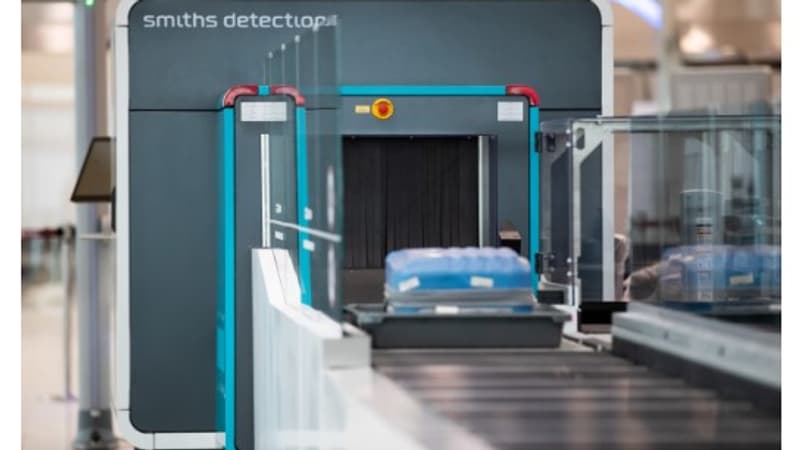This is one of the rituals of air travel that we would all like to forget, especially in summer when the airports are crowded: the obligation to go out and present liquids and computers from your hand luggage at the time of departure. security checks before boarding.
In addition to this obligation, it is also necessary to ensure that these liquids meet the criteria of size (100 ml) and container (transparent) under penalty of confiscation.
This security protocol for the detection of explosives obviously lengthens boarding times (and constitutes an irritant factor for passengers), a particularly delicate situation in a context of shortage of personnel at airports.
“We went from X-rays to MRI”
But there is something new in this. Thanks to the latest generation of security equipment, today it is theoretically possible to detect explosives without having to remove anything from a piece of luggage.
These state-of-the-art CT/3D scanners using computed tomography (initially used in hospitals) are already a reality at US airports, such as New York’s John F. Kennedy, Atlanta’s Hartsfield-Jackson and O’Chicago Hare.
In Europe, these solutions are currently in the testing or pre-deployment phase, particularly in Great Britain, Portugal, the Netherlands and at least two sites in France.
In Paris-Orly, a test started on Orly 3 in October 2022 and will take place over a year in a real situation on two control lines.
“The gain for the passengers is clear, the preparation time during the control is reduced by a third to 60 seconds. Upon analysis, we get fewer pat-downs that are a real hassle for passengers. We went from 13% to 8% of manual excavations”, continues the person in charge.
Clearly stated time savings for passengers
On the contrary, the time for analysis of the image by the agent is longer. “It is quite logical, this new technology requires specific training and learning in front of the screen. You have to have the tool in your hand, know how to read a 3D image, the analysis is more complex”, explains Justine Coutard.
According to our information, tests of this new equipment will also take place this year at Roissy Charles-de-Gaulle.
For almost a month, this device has also been tested in Lyon-Saint Exupéry for a period of six months on “two lines of PIF (Filtering Inspection Post). This test has just been formalized by Vinci Airports, which operates the airport “.
“The Vinci Airports teams at Lyon airport are mobilizing together with the State services to implement innovative solutions that speed up the journey of our passengers and guarantee the reliability of the controls.. By bringing together the various actors involved (the airport operator, the DGAC, the security service provider and the equipment manufacturer), this experiment will allow an evaluation in the place new security equipment and will contribute to the French reflection on the deployment of this type of devices”, comments Ludovic Gas, director of operations of Aéroports de Lyon.
As ADP or Vinci point out, these tests have been promoted and supervised by the State through the DGAC’s “Visión Seguridad” national innovation program launched in 2014. It has already enabled tests of scanning booths for passengers or shoe analyzers (shoescan ) that detect metal and explosive threats.
“A true common desire to advance this issue”
The second phase of this program initiated in 2018 (by Elisabeth Borne, then Minister of Transport) has as its objective precisely “to promote innovation in terms of safety to support the growth of air transport. The innovative solutions proposed will refer to inspection-filtration of passengers and their cabins, but also the inspection of checked baggage and freight and mail”.
Still, these initiatives are limited to testing for now. “The projects will be evaluated, among other things, in the effectiveness of threat detection, in operational efficiency and in economic efficiency,” the document detailing the “Vision Security” project can be read to the project leaders.
Therefore, it is impossible for the moment to speak of a generalization schedule. We will have to wait for feedback, analysis of the fluidity/security relationship and official validations, which will take time.
no calendar yet
“We can imagine new deployments in the coming months but a generalization will depend a lot on the DGAC, which is the only one that can influence the regulations” underlines the boss of Orly who also raises the question of costs and technical limitations with machines much larger than the ones above, which requires adjustments in the control areas.
Above all because it is the European standards that take precedence in terms of airport security and the current texts will have to be adapted. “The European framework is strict but each country can integrate national adaptations into it. And this framework is not incompatible with these new technologies ”, he tempers.
However, the rationalization of the flow is urgent: the resumption of traffic and the massive arrival of athletes for the Olympic Games in Paris next year, some of whom will be accompanied by their equipment (javelin, pole vault, etc.) are at risk to put unprecedented pressure on passenger flow at French airports that must also reduce chronic staff shortages, especially in security.
Source: BFM TV


